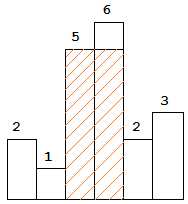标签:ble 第一个 计算 null har val src ace 这一
【例子1】132 Pattern
https://leetcode.com/problems/132-pattern/description/
Given a sequence of n integers a1, a2, ..., an, a 132 pattern is a subsequence ai, aj, ak such that i < j < k and ai < ak < aj. Design an algorithm that takes a list of n numbers as input and checks whether there is a 132 pattern in the list.
Note: n will be less than 15,000.
思路:求一个list中是否有132模式。利用一个栈,从后往前遍历数组,再设置一个second变量。栈中记录的是当前遍历到的最大值,而second则用来记录目前第二大的数。只要目前遍历的数,小于栈顶的最大值和second,这时候就刚好满足132模式。
代码:

bool find132pattern(vector<int>& nums) { if(nums.size()<3)return false; stack<int> s; int second=INT_MIN; for(int i=nums.size()-1;i>=0;i--){ if(nums[i]<second)return true; while(!s.empty()&&nums[i]>s.top()){ second = s.top(); s.pop(); } s.push(nums[i]); } return false; }
【例子2】直方图中的最大矩形
https://leetcode.com/problems/largest-rectangle-in-histogram/description/
Given n non-negative integers representing the histogram‘s bar height where the width of each bar is 1, find the area of largest rectangle in the histogram.


思路:这道题目有多种解法,例如:动态规划、分治法、线段树等等。这里主要讲一下用栈解决的思路。那么,最大矩形什么时候出现呢?
首先,最大矩形必定恰好包含了图中的一个直方,例如上面的右图。因此,我们只要计算出恰好包含第一个直方的最大矩形、恰好包含第二个直方的.最大矩形..然后得到其中的最大值就行了。
接着,考虑如何计算这些矩形的面积,它们的高就是恰好包含的直方的高h,只要计算各个矩形的跨度(L,R)即可,L表示矩形开始的位置,R表示结束位置。这时候的矩形面积就是h*(R-L+1)。如上面的右图的阴影部分,R=3,L=2。
最后,最大矩形的右边界很容易确定,只要出现一个直方h[j]小于当前直方h[i],就说明恰好包含h[i]的最大矩阵的右边界是j-1。但是开始的位置在哪里呢?这就需要用到栈,用栈来记录恰好包含第i个直方的最大矩阵的左边界。具体的计算过程,从左至右先将直方的下标逐一入栈s,如果遇到h[i]<s.top(),那么,就说明恰好包含h=s.top()的最大矩阵在R=i-1的位置结束,而它的左边界就是在s.pop()之后,L=s.top()+1,这时候的面积就是h*(R-L+1)。计算的过程中,与之前的结果比较大小,得到直方图的最大矩阵面积。
注意:按照上面的思路,我们在遍历h数组之后,最后的栈中并不一定为空。这是因为,存在直方的高度小于最右边的直方。在开始阶段,往数组h最右边插入一个0作为结束,就能够计算到每一个直方的最大矩阵面积了。
代码:

int largestRectangleArea(vector<int>& h) { h.push_back(0); int res = 0; vector<int> pos; for(int i=0;i<h.size();i++){ while(!pos.empty()&&h[i]<=h[pos.back()]){ int cur = h[pos.back()]; pos.pop_back();//出栈 int sidx = pos.empty() ? -1:pos.back(); res = max(res, cur*(i-sidx-1)); } pos.push_back(i); } return res; }
【例子3】最大全1子矩阵
https://leetcode.com/problems/remove-duplicate-letters/description/
Given a 2D binary matrix filled with 0‘s and 1‘s, find the largest rectangle containing only 1‘s and return its area.
For example, given the following matrix:
1 0 1 0 0 1 0 1 1 1 1 1 1 1 1 1 0 0 1 0
Return 6.
思路:这个题目本质上和上一题是相同的,可以相互转化,上一题中可以转化为一个0-1矩阵,求最大全1子矩阵的大小即可。这一个问题也可以将各行分别看作直方图的x坐标,求出当前的最大子矩阵,然后比较得到各行当中的最大值即可。例如,第1-1行可以看作是一个直方图,第1-2行可以看作是一个直方图....矩阵中的最大全1子矩阵就从各个直方图的最大矩阵中去找。不多说了,上代码:
代码:

int maximalRectangle(vector<vector<char>>& m) { if(m.empty()) return 0; vector<int> h(m[0].size(),0); int res = 0; for(int i=0;i<m.size();i++){ for(int j=0;j<m[0].size();j++){ if(m[i][j]==‘0‘) h[j] = 0; else h[j]++; } res = max(res,largestRectangleArea(h)); } return res; } int largestRectangleArea(vector<int>& h) { h.push_back(0); int res = 0; vector<int> pos; for(int i=0;i<h.size();i++){ while(!pos.empty()&&h[i]<=h[pos.back()]){ int cur = h[pos.back()]; pos.pop_back(); int sidx = pos.empty() ? -1:pos.back(); res = max(res, cur*(i-sidx-1)); } pos.push_back(i); } return res; }
【例子4】Verify Preorder Serialization of a Binary Tree
https://leetcode.com/problems/verify-preorder-serialization-of-a-binary-tree/description/
One way to serialize a binary tree is to use pre-order traversal. When we encounter a non-null node, we record the node‘s value. If it is a null node, we record using a sentinel value such as #.
_9_
/ 3 2
/ \ / 4 1 # 6
/ \ / \ / # # # # # #
For example, the above binary tree can be serialized to the string "9,3,4,#,#,1,#,#,2,#,6,#,#", where # represents a null node.
Given a string of comma separated values, verify whether it is a correct preorder traversal serialization of a binary tree. Find an algorithm without reconstructing the tree.
思路:验证是否为二叉树的先序序列。从左到右将各字符入栈,如果遇到栈顶字符是“#”,当前待压入栈中的字符是“#”,就说明栈顶的前一个字符是叶子节点,这时候,连续两个pop(),消去这个叶子节点。这时候,叶子节点的位置就是null,需要将“#”压入栈中。如果满足前面的条件,继续消去。如果遍历完整个字符串之后,栈中留下的只有一个“#”,就说明是先序序列。不过,如果出现连续三个“#”或者栈中只剩两个“#”的情况,这时候肯定不是先序序列,这要在栈的操作过程中加以判断。
另外,参考别人的discuss,二叉树只有度为0和度为2的两种节点,而根据公式:n0 = n2 + 1。如果在遍历的过程中遇到了n0>=n2+1(这时候遍历还未结束),就说明这个序列有问题了。同样,遍历完之后,如果n0!= n2 + 1,这也说明不是先序序列。
代码:

bool isValidSerialization(string pre) { char tmp; bool isNum = false; pre += ‘,‘; vector<char> s; for(auto tmp:pre){ if(tmp==‘#‘){ while(!s.empty()&&s.back()==‘#‘){ s.pop_back(); if(s.empty()||s.back()==‘#‘)return false;//case“###” s.pop_back(); } s.push_back(‘#‘); }else if(tmp==‘,‘){ if(isNum)s.push_back(‘n‘); isNum = false; }else{ isNum = true; } } return s.back()==‘#‘&&s.size()==1; }
【例子5】二叉树的后序遍历(用栈)
思路:二叉树的用栈后序遍历,比用栈前序、中序遍历都要复杂,方法也比较多。
思路一,根据(左右中)的顺序,先将r压栈,再出栈,将r->left压栈,将r->right压栈,再将栈顶(r->right)出栈....这样就能够遍历到二叉树的每个节点,最后栈为空。可以发现,这样的出栈序列和二叉树的后序序列刚好相反。所以,我们只要在出栈的时候讲val存入vector数组,再反转即可,也可以采用insert函数,将每一次的val插入vector的首位。
思路二,如果我们的目的仅仅是输出后序序列,同时,是否输出当前节点,只需要看看它的左右节点是否输出,或者左右节点是否为空。所以,添加一个pre变量,代表前一次访问的节点。在栈不为空的情况下,按照s.top()->right、s.top()->left的方式依次入栈。当目前栈顶元素的左右节点都未null,或者,pre节点是左节点且右子树为null,pre节点是右节点的时候,就输出栈顶val,再出栈,pre就等于当前出栈节点。这样循环下去,直到栈为空。

//思路一: vector<int> postorderTraversal(TreeNode* r) { vector<int> v; if (!r) return v; stack<TreeNode*> s; s.push(r); while(!s.empty()){ TreeNode* cur = s.top(); v.insert(v.begin(),cur->val); s.pop(); if(cur->left)s.push(cur->left); if(cur->right)s.push(cur->right); } return v; } //思路二: vector<int> postorderTraversal(TreeNode* r) { vector<int> v; if (!r) return v; stack<TreeNode*> s; TreeNode* pre; s.push(r); while(!s.empty()){ TreeNode* cur = s.top(); if((!cur->left&&!cur->right)||(pre == cur->left&&!cur->right)||(pre&&pre==cur->right)){ v.push_back(cur->val); s.pop(); pre = cur; }else{ if(cur->right)s.push(cur->right); if(cur->left)s.push(cur->left); } } return v; }
【例子6】中缀表达式求值
思路:中缀就是我们平常所见的表达式序列。直接进行中缀求值需要用两个栈,一个栈存操作数,一个栈存放操作符,包括“+-*/()”。如果遍历的操作符优先级不比栈顶操作符大,就将栈顶操作符出栈,同时将两个操作数出栈,计算得到的结果再入栈。
为了减少操作数压栈入栈的次数,设置一个cur变量,代表当前得到的操作数。在需要计算的时候,只需将一个操作数出栈,计算得到的结果仍然是cur,直到目前的操作符优先级大于当前栈顶的优先级,才将cur压入栈中。
另外,考虑到遍历之后,两个栈中仍然有数据需要计算,这样就会有比较重复的代码了。为了解决这个问题,只需在最开始的时候,给表达式加上括号,这样在遍历之后,两个栈全部清空,这时候表达式的值就是cur。

#include<iostream> #include<cstring> #include<stack> #include<unordered_map> #include<unordered_set> #include<functional> using namespace std; unordered_map<char, function<int (int, int )>> op_map = { { ‘+‘ , [] (int a, int b) { return a + b; } }, { ‘-‘ , [] (int a, int b) { return a - b; } }, { ‘*‘ , [] (int a, int b) { return a * b; } }, { ‘/‘ , [] (int a, int b) { return a / b; } } }; unordered_map<char, int> priority = { {‘+‘,1},{‘-‘,1},{‘*‘,2},{‘/‘,2},{‘(‘,0} }; /* 利用两个栈进行模拟计算 */ int Compute(string s) { stack<char> opstk; //操作符栈 stack<int> numstk; //操作数栈 int pos = 0; s = "(" + s + ")"; int cur; while(pos < s.length()) { if (s[pos] == ‘(‘){ opstk.push(‘(‘); if(s[++pos]==‘-‘)cur = 0;//负号必定出现在‘(‘的后面,变成减法 }else if (s[pos] == ‘)‘){ //括号内计算得到的cur不需要入栈 while (opstk.top() != ‘(‘){ cur = op_map[opstk.top()](numstk.top(), cur);//只需拿cur与栈顶数字进行计算 numstk.pop(); opstk.pop(); } opstk.pop(); //删除‘(‘ pos++; }else if (s[pos] >= ‘0‘ && s[pos] <= ‘9‘){ int integer = 0; while (s[pos] >= ‘0‘ && s[pos] <= ‘9‘){ integer = integer*10 + (s[pos++] - ‘0‘); } cur = integer; }else{ while(priority[s[pos]] <= priority[opstk.top()]){ cur = op_map[opstk.top()](numstk.top(), cur); numstk.pop(); opstk.pop(); } numstk.push(cur); opstk.push(s[pos++]); } } return cur; } int main() { string s = "-2+3*(-2+3*4)-(-(-2))"; cout << "结果为:" << Compute(s) << endl;//输出结果为26 return 0; }
总结:如果问题的结构类似于(A(B)(C(D(E)))),其中A代表原问题,B、C、D分别代表嵌套的子问题,一个括号表示一个完整子问题的左右边界,完整意味着这个子问题的解可能是最后的最优解,或者说是最终解中的一部分。在这里原问题的解决需要先解决嵌套的子问题,这时候就可以用栈来解决问题。这里我总结出一个不成熟的方法,既然括号的匹配是最典型的的栈问题,那么,我们可以用括号来划分那些完整的子问题。就拿例子2来说,2,1,5,6,2,3,可以划分为( (2), 1, ((5, (6)), 2, (3))),每一个括号里面只有一个单独的数字,括号就刚好代表该高度的矩形的跨度。即使不知道能否用栈,只要我们能够标明括号,来划分完整的子问题,这就很容易得到用栈的解决方法了。左括号入栈,右括号出栈,其他操作.....这样执行下去,直到找到答案。另外,拿例子1来说,1, 3, 6, 4, 2,用栈的话就是(((2), 4), 6), 3, 1,当然,能够这样做的前提就是,我们需要意识到数组从右至左最大值和次大值的重要性。
标签:ble 第一个 计算 null har val src ace 这一
原文地址:http://www.cnblogs.com/hello-new-world/p/7289615.html